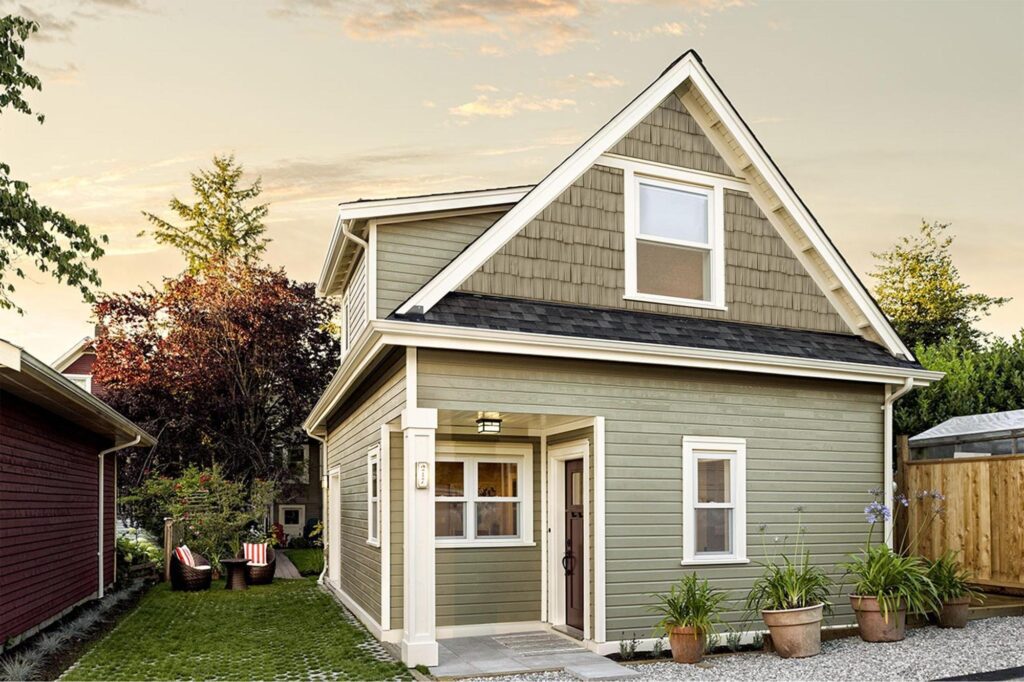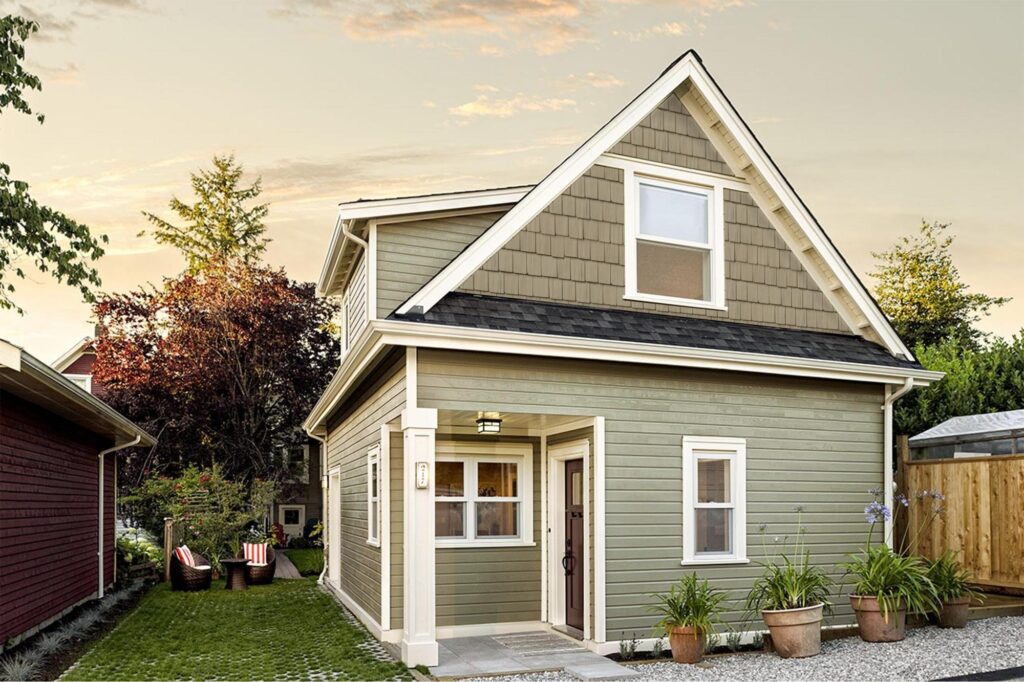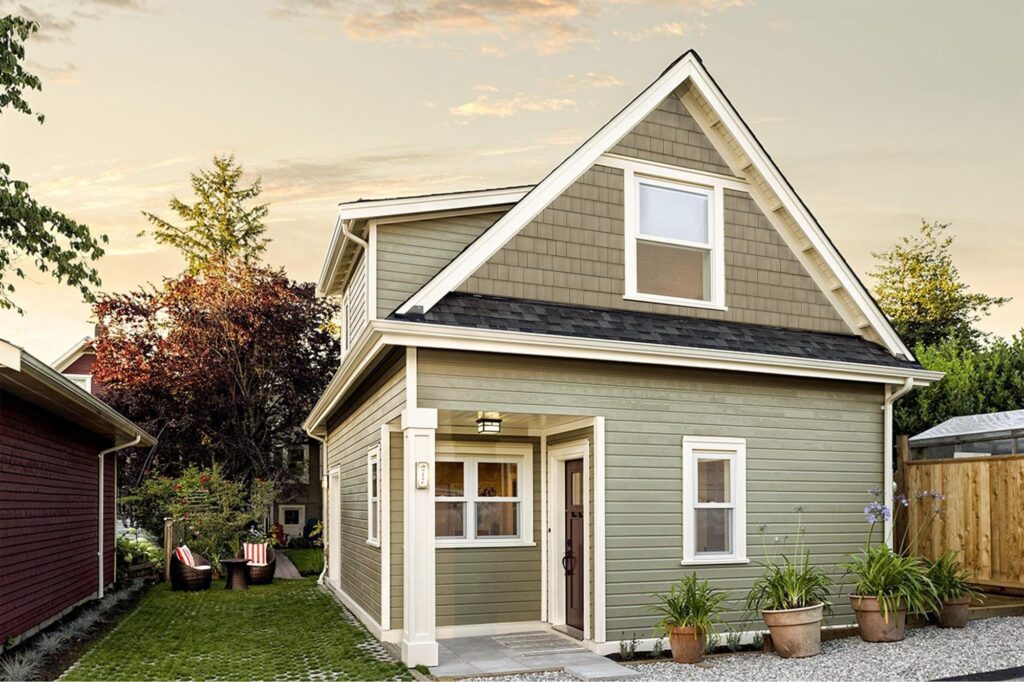Shake Vinyl Siding – A Modern Twist on Classic Design
- Combines cedar shake charm with vinyl’s durability and efficiency.
- Preferred due to its natural cedar look, low maintenance, and cost-effectiveness.
- Can be installed both horizontally (classic look) and vertically (modern look).
- Offers various textures, colors, grain patterns, and material compositions.
- More affordable than genuine cedar considering reduced maintenance.
- Requires expert installation but promises longevity.
- Few drawbacks: slightly longer installation time and need for secure setup.
- Overall, a smart blend of traditional aesthetics and modern benefits.
In the vast tapestry of architectural styles, cedar shakes have consistently stood out, bestowing homes with an undeniable rustic allure that spans centuries. This age-old material has always been revered for its natural beauty and timeless aesthetic. But as we stand at the confluence of tradition and innovation, the world of home design is witnessing a significant shift. Enter shake vinyl siding, and more notably, the cedar shake vinyl siding. This contemporary adaptation offers several advantages:
Aesthetic Appeal: Captures the quintessential charisma of cedar, seamlessly blending the old with the new.
Modern Efficiency: While paying homage to traditional cedar, it sidesteps the typical challenges associated with natural wood, such as susceptibility to pests and high maintenance.
Versatility: Suits various architectural designs, proving that tradition can be flexible.
Durability: Merges the endurance of vinyl with the look of cedar, providing homeowners the best of both worlds.
SECTION TAKEAWAY
- Shake vinyl siding replicates the aesthetic of cedar shakes without maintenance challenges.
- The detailing on this siding is so precise it can fool even experts.
- Environmentally friendly: Vinyl is recyclable and long-lasting.
- Cost-effective compared to traditional cedar, saving on both installation and maintenance.
Why are Homeowners Drifting Towards Shake Vinyl Siding?
Shake vinyl siding offers a rich texture that emulates the natural look of cedar shakes. This look has been sought-after for its rustic charm and its ability to give homes a characteristically timeless feel. What sets shake vinyl siding apart is its promise of the aesthetic allure of cedar without the traditional complications of maintenance. This means homeowners can enjoy the organic, textured appearance without worrying about the vulnerabilities that come with genuine wood – from moisture-induced decay to termite infestations.
Additionally, with advancements in manufacturing processes, the detailing on shake vinyl siding has reached impeccable precision. The grains, the patterns, and even the imperfections of natural wood are replicated with such finesse that it often leaves even experts second-guessing. For homeowners, this means having a home exterior that stands out, without the accompanying frequent upkeep.
Moreover, the global push towards sustainable living has seen homeowners opt for materials that are not just durable but also environmentally friendly. Vinyl, being recyclable, and requiring less frequent replacements, fits this criterion, making shake vinyl siding a green choice.
Lastly, the cost factor cannot be ignored. Traditional cedar shakes, while beautiful, can be quite heavy on the pocket, both in terms of initial installation and ongoing maintenance. Shake vinyl siding, on the other hand, offers a cost-effective alternative that doesn’t compromise on looks.
SECTION TAKEAWAY
- Shake vinyl siding is versatile, offering a plethora of styles, textures, and colors.
- Varieties include different textures (Hand-Split, Sawn, Staggered Edge, Straight Edge) and colors (natural, modern, weathered).
- Grain patterns range from fine to bold, with an option for a more unpredictable appearance.
- Materials include pure vinyl or composites, each with unique durability aspects.
- Finishes protect against UV, extreme temperatures, and moisture.
- The diversity allows homeowners to customize siding to their specific aesthetic and functional needs.
Horizontal or Vertical? Which Suits Shake Vinyl Siding Best?
Like its vinyl counterparts, shake vinyl siding is versatile in its installation. While traditional cedar shakes are predominantly horizontal, vinyl shakes aren’t constrained by such norms. Vertical installations can add a fresh spin, potentially elongating the appearance of your home. However, for those who swear by tradition, horizontal installations offer the classic look that’s been adored for ages.
A Dive into Different Varieties of Shake Vinyl Siding
The world of shake vinyl siding is vast, diverse, and intricately detailed, catering to a myriad of tastes and preferences. Homeowners seeking to refresh or redefine their exteriors will find that shake vinyl siding comes in an array of styles, textures, and hues. Below are some notable variations:
Texture & Design Varieties
Hand-Split Replicas: Mimics the look of shakes that have been manually split using tools. These have a rugged and organic appearance, embodying a rustic charm.

Staggered Edge: Features alternating widths and slightly shifted placements, lending a more dynamic and less uniform look to exteriors.

Straight Edge: Offers a cleaner, streamlined appearance with uniform widths and placements.

Sawn Shakes: Resemble shakes that are sawn rather than split, resulting in a more uniform and cleaner appearance.
Color Spectrum
- Natural Hues: Common colors that replicate the genuine look of wood, like cedar brown, autumn yellow, and rustic red.
- Contemporary Tones: Modern shades such as graphite gray, ocean blue, and earthy green, allowing homeowners to make bolder statements.
- Weathered Look: Colors that give the appearance of aged or weathered wood, adding a historical or vintage touch.
Grain Patterns
- Fine Grain: A subtle and smooth grain that gives a refined appearance.
- Bold Grain: A more pronounced grain pattern, reflecting the authentic, rough texture of natural wood.
- Random Grain: An uneven grain pattern for those seeking a more organic and unpredictable look.
Material Compositions
- Pure Vinyl: Comprises solely of vinyl, offering maximum durability and resistance to elements.
- Composite: A blend of vinyl and other materials like wood fibers, providing a balance between authenticity and durability.
Finish & Coating
- UV-Resistant Coating: To prevent fading from prolonged sun exposure.
- Thermal Resistance: Specially designed to insulate homes and withstand extreme temperatures.
- Mold and Mildew Resistance: For humid climates or homes in moisture-prone areas.
SECTION TAKEAWAY
- Shake vinyl siding is versatile, offering a plethora of styles, textures, and colors.
- Varieties include different textures (Hand-Split, Sawn, Staggered Edge, Straight Edge) and colors (natural, modern, weathered).
- Grain patterns range from fine to bold, with an option for a more unpredictable appearance.
- Materials include pure vinyl or composites, each with unique durability aspects.
- Finishes protect against UV, extreme temperatures, and moisture.
- The diversity allows homeowners to customize siding to their specific aesthetic and functional needs.
Making the Investment Decision: Is Shake Vinyl Siding More Expensive?
Financial considerations always play a role in home renovations. At a glance, shake vinyl siding might seem like a pricier option compared to regular vinyl siding, given its intricate design.
However, when one accounts for the diminished maintenance costs and the increased lifespan, the scales might tip in its favor. Plus, if you’re aiming for that cedar shake look, vinyl alternatives are notably cheaper than genuine cedar installations.
Ease of Installation: A Closer Look
Drawing parallels with the vertical vinyl siding, shake vinyl siding might seem challenging to install due to its distinct design. But, in the hands of experienced professionals, this challenge is easily surmounted. Proper measurements and cuts are essential for that seamless finish. It’s also imperative to ensure that there’s an appropriate underlayment to shield the siding from potential water damage while providing insulation.
Are There Any Drawbacks to Shake Vinyl Siding?
Like every product, shake vinyl siding isn’t without its cons. For instance, due to the specificity of its design, it might demand more time for installation compared to basic vinyl siding. This could also translate to slightly elevated installation costs. Additionally, ensuring that the siding is secure is paramount, especially in areas prone to strong winds. But, with the right installation techniques, these challenges can be easily navigated.
Ensuring Longevity: Will Shake Vinyl Siding Stand the Test of Time?
One of the reasons homeowners gravitate towards vinyl siding is its promise of durability. Shake vinyl siding is no different. With the right care and occasional cleaning, this siding can resist the elements, be it rain, sun, or snow. However, ensuring it’s installed with precision and the recommended underlay is the key to maximizing its lifespan.
Conclusion
Shake vinyl siding, particularly its cedar variant, offers homeowners a rare blend – the nostalgia of traditional design coupled with the benefits of contemporary materials. It encapsulates the essence of timeless beauty while sidelining the drawbacks of natural cedar shakes. For homeowners on the cusp of decision-making, shake vinyl siding isn’t just an aesthetic choice; it’s a smart, future-proof investment.


